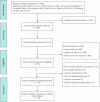Association of dietary nitrate and nitrite from plant sources with digestive system cancer risk: a systematic review and meta-analysis
- PMID: 40713740
- PMCID: PMC12297779
- DOI: 10.1186/s12986-025-00973-6
Association of dietary nitrate and nitrite from plant sources with digestive system cancer risk: a systematic review and meta-analysis
Abstract
Background: Recent studies have indicated that dietary nitrate intake from plant sources offers numerous health benefits. However, the relationships between the intake of plant-derived nitrates and nitrites and the risk of digestive system cancers (DSCs) remain unclear. This study aimed to quantify the associations between dietary nitrate and nitrite from plant sources and the risk of DSCs via a systematic review and meta-analysis.
Methods: We conducted extensive literature searches of the PubMed, Embase, Scopus, Web of Science, CINAHL, Cochrane Library, CNKI, VIP, Wanfang, and CBM databases up to April 2024. STATA 14.0 was applied for meta-regression and meta-analysis, and fixed or random effects models were used to calculate the pooled relative risks and 95% confidence intervals. Sensitivity and subgroup analyses were conducted to explore sources of heterogeneity.
Results: Our analysis included 13 articles with a total of 897,585 participants, which included 10 different types of digestive tumors. The pooled results indicated no significant association between high (median: >134.9 mg/day) [RR = 0.92; 95% CI (0.82-1.03); P = 0.14] or moderate (median: 83.0-133.1 mg/day) [RR = 0.95; 95% CI (0.89-1.02); P = 0.186] nitrate intake and DSCs. Similarly, neither high (median: >0.91 mg/day) [RR = 0.91; 95% CI (0.84-1.00); P = 0.05] nor moderate (median: 0.75 mg/day) [RR = 0.96; 95% CI (0.89-1.04); P = 0.355] nitrite intake was correlated with DSCs. However, a negative association was observed between nitrate or nitrite intake and DSCs when the data were stratified by subgroup variables such as study type, sex, region, antioxidant intake, and fibre intake. A meta-regression dose‒response analysis revealed that the risk of gastric cancer was negatively associated with the median intake of plant-derived nitrates [slope= -0.0047 per mg/day; 95% CI (-0.0086--0.0008); P = 0.022].
Conclusions: Plant-derived nitrate and nitrite intakes were not significantly associated with DSCs. This relationship may be affected by subgroup variables, and a dose‒response analysis indicated that higher nitrate intake was linked to a reduced risk of gastric cancer.
Keywords: Digestive system cancers (DSCs); Meta-analysis; Nitrate; Nitrite; Plant sources.
© 2025. The Author(s).
Conflict of interest statement
Declarations. Ethics approval and consent to participate: Not applicable. Consent for publication: Not applicable. Competing interests: The authors declare no competing interests.
Figures







References
-
- Sung H, Ferlay J, Siegel RL, Laversanne M, Soerjomataram I, Jemal A, et al. Global Cancer statistics 2020: GLOBOCAN estimates of incidence and mortality worldwide for 36 cancers in 185 countries. CA Cancer J Clin. 2021;71(3):209–49. - PubMed
-
- Rock CL, Thomson CA, Sullivan KR, Howe CL, Kushi LH, Caan BJ, et al. American Cancer society nutrition and physical activity guideline for cancer survivors. CA Cancer J Clin. 2022;72(3):230–62. - PubMed
-
- Islami F, Goding Sauer A, Miller KD, Siegel RL, Fedewa SA, Jacobs EJ, et al. Proportion and number of cancer cases and deaths attributable to potentially modifiable risk factors in the united States. CA Cancer J Clin. 2018;68(1):31–54. - PubMed
-
- Gassara F, Kouassi AP, Brar SK, Belkacemi K. Green alternatives to nitrates and nitrites in Meat-based Products-A review. Crit Rev Food Sci Nutr. 2016;56(13):2133–48. - PubMed
Publication types
Grants and funding
LinkOut - more resources
Full Text Sources
Miscellaneous

